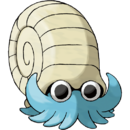From Bulbapedia, the community-driven Pokémon encyclopedia.
|
|

Artwork from FR/LG
|
|
|
|
|
|
|
|
|
|
|
|
Height
1'04"
Imperial
|
0.4 m
Metric
|
1'04"/0.4 m
Red-Striped
|
0'0"/0.0 m
Blue-Striped
|
0'0"/0.0 m
|
|
|
Weight
16.5 lbs.
Imperial
|
7.5 kg
Metric
|
16.5 lbs./7.5 kg
Red-Striped
|
0.0 lbs./0.0 kg
Blue-Striped
|
0.0 lbs./0.0 kg
|
|
|
|
|
|
|
|
|
|
|
|
|
EV yield
HP
0
|
Atk
0
|
Def
1
|
Sp.Atk
0
|
Sp.Def
0
|
Speed
0
|
| Base Exp.: 99
|
Battle Exp.: 991*
|
|
|
|
|
Omanyte (Japanese: オムナイト Omnite) is a dual-type Rock/Water Pokémon.
It is resurrected from a Helix Fossil and then evolves into Omastar starting at level 40.
Biology
Physiology
Omanyte has a large, pale-yellow shell on its back. Its main body is sky-blue with 10 tentacles (two of them are longer than the other eight). Omanyte has saucer-like eyes. Omanyte uses the many gas filled chambers in their helix shell to remain buoyant in the water column. They regulate their height by evacuating gases from compartments.
Gender differences
None.
Special abilities
Omanyte learns several Water-based moves and a small handful of Template:Type2 moves. Unlike many Rock-types, Omanyte cannot learn Earthquake.
Behavior
Habitat
The exact habitat of Omanyte is unknown even though there have been records of Omanyte hiding deep in damp caves, but so far Helix Fossils are only found in the Kanto and Sinnoh regions.
Diet
- Main article: Pokémon food
Unlike its evolved form, Omastar, this Pokémon feeds on plankton in the wild.
In the anime
Ash first encountered Omanyte in Attack of the Prehistoric Pokémon along with all the other Generation I fossil Pokémon. A dynamite blast woke up the fossil Pokémon living deep beneath Grandpa Canyon. They chased Ash and Team Rocket around until an Aerodactyl showed up and scared them off.
Omanyte and its evolved form, Omastar, were discovered to be living in the Ruins of Alph and moved to a museum in Fossil Fools.
Another one appeared in Dealing With Defensive Types!.
Pokédex entries
| Episode
|
Pokémon
|
Source
|
Entry
|
| EP046
|
Omanyte, Omastar, Kabuto, and Kabutops
|
Ash's Pokédex
|
Omanyte and Omastar, Kabuto and Kabutops. It is believed these Pokémon became extinct tens of thousands of years ago. The details of their behavior are shrouded in mystery. Though some have speculated that they may still exist, none of these Pokémon have ever been seen alive.
|
| Original series entries continue below.
|
|
| Episode
|
Pokémon
|
Source
|
Entry
|
| EP163
|
Omanyte
|
Ash's Pokédex
|
Omanyte, the Spiral Pokémon. Believed to have lived over 2 billion years ago. Recent research indicates that it was able to control its bouyancy by storing and releasing air in its shell.
|
|
In the manga
Pokémon Special
Misty had an Omanyte which she gave to Yellow in Template:PSV. Later, it evolves into Omastar.
In the TCG
- Main article: Omanyte (TCG)
Game data
Pokédex entries
| This Pokémon was unavailable prior to Generation I.
|
| Generation I
|
|
| Red
|
Although long extinct, in rare cases, it can be genetically resurrected from fossils.
|
| Blue
|
| Yellow
|
An ancient Pokémon that was recovered from a fossil. It swims by cleverly twisting its 10 tentacles about.
|
| Stadium
|
A prehistoric and long-extinct Pokémon that was resurrected from a fossil. Swims by twisting its 10 tentacles about.
|
|
|
| Generation II
|
|
| Gold
|
Revived from an ancient fossil, this Pokémon uses air stored in its shell to sink and rise in water.
|
| Silver
|
This Pokémon from ancient times is said to have navigated the sea by adeptly twisting its 10 tentacles.
|
| Crystal
|
In prehistoric times, it swam on the sea floor, eating plankton. Its fossils are sometimes found.
|
| Stadium 2
|
Revived from an ancient fossil, this Pokémon uses air stored in its shell to sink and rise in water.
|
|
|
| Generation III
|
|
| Ruby
|
Omanyte is one of the ancient and long-since-extinct Pokémon that have been regenerated from fossils by people. If attacked by an enemy, it withdraws itself inside its hard shell.
|
| Sapphire
|
Omanyte is one of the ancient and long-since-extinct Pokémon that have been regenerated from fossils by people. If attacked by an enemy, it withdraws itself inside its hard shell.
|
| Emerald
|
One of the ancient and long-since-extinct Pokémon that have been regenerated from fossils by humans. If attacked, it withdraws into its hard shell.
|
| FireRed
|
A prehistoric Pokémon that lived in the primordial sea, it swims by twisting its 10 tentacles about.
|
| LeafGreen
|
Although long extinct, in rare cases, it can be genetically resurrected from fossils.
|
|
|
| Generation IV
|
|
| Diamond
|
A Pokémon that was resurrected from a fossil using modern science. It swam in ancient seas.
|
| Pearl
|
A Pokémon that was resurrected from a fossil using modern science. It swam in ancient seas.
|
| Platinum
|
A Pokémon that was resurrected from a fossil using modern science. It swam in ancient seas.
|
| HeartGold
|
{{{heartgolddex}}}
|
| SoulSilver
|
{{{soulsilverdex}}}
|
|
|
|
|
|
|
Game locations
| This Pokémon was unavailable prior to Generation I.
|
|
|
|
|
|
|
|
|
|
|
|
|
In side games
Held items
Base stats
| Stat
|
Range
|
| At Lv. 50
|
At Lv. 100
|
35
|
|
95 - 142
|
180 - 274
|
40
|
|
40 - 101
|
76 - 196
|
100
|
|
94 - 167
|
184 - 328
|
90
|
|
85 - 156
|
166 - 306
|
55
|
|
54 - 117
|
103 - 229
|
35
|
|
36 - 95
|
67 - 185
|
Total: 355
|
Other Pokémon with this total
|
- Minimum stats are calculated with 0 EVs, IVs of 0, and (if applicable) a hindering nature.
- Maximum stats are calculated with 252 EVs, IVs of 31, and (if applicable) a helpful nature.
- This Pokémon's Special base stat in Generation I was 90.
|
Type effectiveness
| Under normal battle conditions in Generation V, this Pokémon is:
|
|
|
|
|
|
|
|
|
|
|
|
|
Learnset
Template:Learnset intro
|- style="text-align:center"
| style="text-align:left" | rock
| style="background:#2980EF" | water
| style=" background:#FFF" | 4
| style=" background:#FFF" | 1
| style=" background:#FFF" | Omanyte
| style="display:none; background:#FFF" | {{{6}}}
Template:Mlentry4
Template:Mlentry4
Template:Mlentry4
Template:Mlentry4
Template:Mlentry4
Template:Mlentry4
Template:Mlentry4
Template:Mlentry4
Template:Mlentry4
Template:Mlentry4
Template:Mlentry4
Template:Mlentry4
Template:Mlentry4
Template:Movelist/note
Template:Movelisttm
Template:Mlentry4
Template:Mlentry4
Template:Mlentry4
Template:Mlentry4
Template:Mlentry4
Template:Mlentry4
Template:Mlentry4
Template:Mlentry4
Template:Mlentry4
Template:Mlentry4
Template:Mlentry4
Template:Mlentry4
Template:Mlentry4
Template:Mlentry4
Template:Mlentry4
Template:Mlentry4
Template:Mlentry4
Template:Mlentry4
Template:Mlentry4
Template:Mlentry4
Template:Mlentry4
Template:Mlentry4
Template:Mlentry4
Template:Mlentry4
Template:Mlentry4
Template:Mlentry4
Template:Mlentry4
Template:Mlentry4
Template:Mlentry4
Template:Mlentry4
Template:Mlentry4
Template:Mlentry4
Template:Mlentry4
Template:Movelist/note
Template:Eggmoves
Template:Mlentry4
Template:Mlentry4
Template:Mlentry4
Template:Mlentry4
Template:Mlentry4
Template:Mlentry4
Template:Mlentry4
Template:Mlentry4
Template:Mlentry4
Template:Mlentry4
Template:Eggmoves/note
Template:Tutor
Template:Mtentry4
Template:Mtentry4
Template:Mtentry4
Template:Mtentry4
Template:Mtentry4
Template:Mtentry4
Template:Mtentry4
Template:Mtentry4
Template:Mtentry4
Template:Mtentry4
Template:Mtentry4
Template:Mtentry4
Template:Mtentry4
Template:Mtentry4
Template:Mtentry4
Template:Mtentry4
|- style="background:#CBC7AD"
| colspan="13" | Bold indicates a move that gets STAB
Italic indicates a move that gets STAB only from an Evolution of this Pokémon
A colored initial indicates that the move is not available to be tutored in this game,
while a colored background indicates that the move is available.
|}
|}
TCG-only moves
Side game data
Template:Side game
Evolution
Sprites
Trivia
- The prototype name for Omanyte was "Ess," the first two letters in "escargot" (the French word for snail) with an additional "s."
- Omanyte's in-game cry is the same as Machop.
- Omanyte can learn Bite despite not having a visible mouth until it evolves into Omastar.
Origin
It is based on the ammonite.
Name origin
Omanyte's name is a phonetic anagram of ammonite, the creature on which it is based.
In other languages
External links
Notes

|
This Pokémon article is part of Project Pokédex, a Bulbapedia project that aims to write comprehensive articles on each Pokémon species, as well as Pokémon groups and forms.
|








































